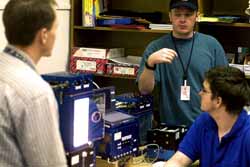Student space project takes flight
A project 10 years in the making finally took flight.
Students at Utah State University’s Space Dynamics Laboratory plan to monitor Lada, a growth chamber that was blasted into space aboard the Russian Soyuz, Progress 9 freighter Wednesday.
Lada is a growth chamber developed by USU students over the past 10 years. The chamber is a greenhouse designed to contribute to scientific experiments by growing vegetables in space.
Jamon Neilson, a senior majoring in physics, said, “Lada is an ancient Russian word for the goddess of spring. Its main purpose is to study plants in a microgravity environment. We’ll investigate how much moisture it needs and how much oxygen it uses. It’s basically the most sophisticated potholder you’ll ever see.”
SDL worked with the Russian Institute of Bio-Medical Problems (IBMP) to develop Lada, which will be hosted in the Russian segment of the International Space Station.
Lada was patterned after the first space greenhouse, the Russian Svet, which was used for seven experiments on the Mir space station between 1990 and 2000. The Mir space station spent 15 years in space where astronauts performed many experiments of historical significance.
Steve Hansen, department director of the SDL, said the attempt was unsuccessful.
“At first they weren’t able to grow anything in space,” he said. “The plants grew, but the seeds that were produced were not viable. So [the Russians] basically came to USU and asked us to build [Lada].”
Lada will house many vegetables, the first of which will be mizuna, a Russian plant similar to lettuce. Shorter, slower-growing plants, like tomatoes, peppers and rice, will be planted in linear rows in the growth chamber. Astronauts will monitor the chamber every day and use the vegetables as meal supplements.
Gail Bingham, SDL Lada program manager, said, “Most experiments that involve plants and animals are all carefully guarded scientific specimens. Nobody is supposed to get any taste of it in space. We’ve taken a different approach. For the past 10 years NASA has been working on ways to sustain life in space. It’s our intent to let the astronauts eat about half of what we grow. Essentially, we can let these plants grow continually.”
Lada is monitored in space from a main control system at SDL.
Cinton Laing, a senior majoring in mechanical engineering, said, “All the functions you can manually invoke, but that’s not the protocol for the system. Lada will run automatically and maintain its own moisture level.”
Lada cost $150,000 to create. By comparison, $2 million was required for Svet.
Neilson said, “We [students] built Lada and it has been managed between SDL and USU. We provided all the hardware and software. The challenging part was just finding the parts we needed. We would get a lot of the supplies to build Lada from Anderson Lumber and Wal-Mart.”
Many facets of education have been integrated into the development of Lada, including research, experimentation, mechanical engineering, electrical engineering and software programming.
The SDL employs more than 100 students on a part-time basis to support their education. Some were given various internships for the past 10 years to build Lada. There are more than 20 students working on its development.
Shane Topham, a graduate student studying electrical engineering, said, “When I first started working here, I was just thrown in with a lot of different students with not a lot of direction.”
The students were often left alone to work on the project.
Laing said, “You have to be a self-motivated person to do this. Sometimes there wasn’t anyone around for weeks.”
SDL has worked on several projects with NASA and IBMP.
Allan Steed, director of SDL, said, “This is a very exciting program for our laboratory. With many years of experience working with NASA and the Russians on Mir, the SDL/USU team has become a world leader in growing plants in space.”
Under the Russian plan, Lada will become a permanent fixture on the ISS with new root systems and supplies sent up as needed. SDL and Russia will have joint ownership of the hardware. Experiments using the hardware will be flown as part of the Russian scientific program with USU investigators as partners.
Topham will fly to Moscow on Tuesday to be the representative on site for Lada and SDL.
-mmackay@cc.usu.edu

Shane Topham, Jamon Neilson and Clinton Laing discuss the uses of Lada, a project they designed to grow crops on the International Space Station. The project was launched in a rocket Wednesday morning and will be set up next week with the help of Topham, who will be flown to Moscow as support. (Photo by Zak Larsen)

